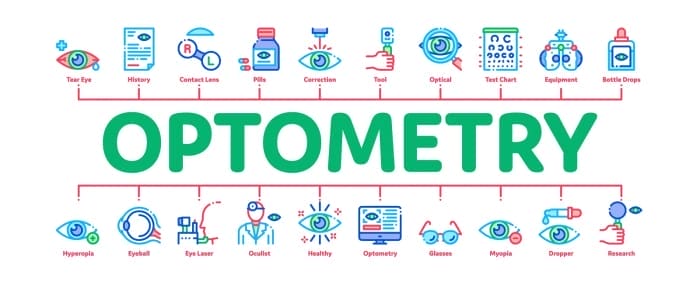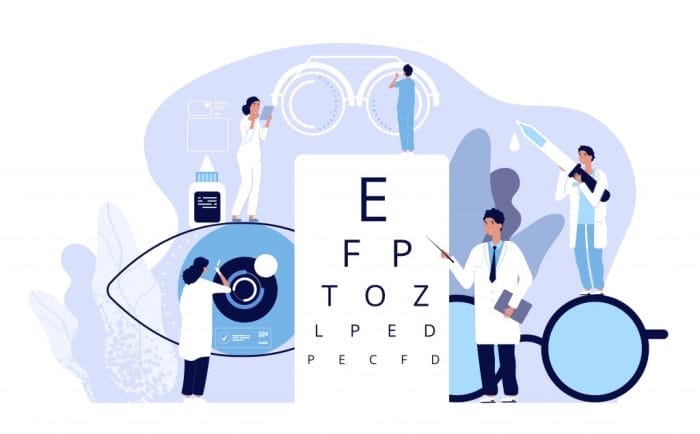In the realm of healthcare, understanding health insurance can be a daunting task, especially when it comes to optometric care. This comprehensive guide aims to demystify the complexities of health insurance coverage for optometric services, providing valuable insights and practical tips to help you make informed decisions and ensure optimal eye care.
With a focus on optometric management, this guide will delve into various aspects of health insurance, including understanding coverage options, prior authorization processes, billing and coding intricacies, and effective communication with patients and insurance companies. By equipping you with this knowledge, you’ll be empowered to navigate the healthcare landscape confidently, ensuring seamless access to essential optometric care.
Health Insurance and Optometry

Health insurance plays a crucial role in covering optometric expenses, ensuring individuals have access to comprehensive eye care and treatment. Various types of health insurance plans offer coverage for optometric care, including routine eye exams, vision correction, and treatment for eye conditions.
Understanding Health Insurance Coverage for Optometry
Health insurance plans vary in their coverage for optometric care. Some plans may offer comprehensive coverage, including routine eye exams, eyeglasses or contact lenses, and treatment for eye conditions. Other plans may have limited coverage, such as coverage for routine eye exams only.
It is essential to understand the coverage provided by your health insurance plan to ensure you have adequate coverage for your optometric needs.
Tips for Choosing the Right Health Insurance Plan for Your Needs
- Consider Your Optometric Needs: Assess your current and potential future optometric needs, such as routine eye exams, vision correction, and treatment for any existing eye conditions. Choose a health insurance plan that provides coverage for the services you require.
- Compare Coverage and Costs: Compare the coverage and costs of different health insurance plans to find one that offers the best value for your money. Consider the premiums, deductibles, copays, and coinsurance associated with each plan.
- Check for In-Network Providers: Ensure that your chosen health insurance plan includes in-network optometrists or eye care providers in your area. This can help reduce your out-of-pocket expenses for optometric care.
- Consider Your Budget: Choose a health insurance plan that fits your budget. Consider the overall cost of the plan, including premiums, deductibles, copays, and coinsurance, to ensure you can afford the coverage.
Understanding Optometric Benefits
Understanding the optometric benefits covered by your health insurance plan is essential for maintaining good eye health and maximizing your coverage. Health insurance plans typically include a range of optometric services, but the specific benefits can vary depending on the plan and your insurance provider.
Determining Optometric Benefits in Your Plan
To determine the specific optometric benefits included in your health insurance plan, you can refer to your plan’s benefits summary or contact your insurance provider directly. The benefits summary should provide details about the covered services, such as routine eye exams, vision tests, and contact lens fittings.
It’s important to carefully review the terms and conditions of your plan to understand any limitations or exclusions.
Common Optometric Services Covered by Health Insurance
Some common optometric services that are typically covered by health insurance include:
- Routine eye exams: These comprehensive eye exams assess your overall eye health and vision, including checking for refractive errors (nearsightedness, farsightedness, and astigmatism).
- Vision tests: Vision tests measure your visual acuity (sharpness) and determine the need for corrective lenses.
- Contact lens fittings: If you require contact lenses for vision correction, your health insurance may cover the cost of contact lens fittings and follow-up visits to ensure proper fit and comfort.
- Eyeglasses or contact lenses: Some health insurance plans may provide coverage for eyeglasses or contact lenses, either partially or fully, depending on the plan’s terms.
- Medical eye care: If you have a medical eye condition, such as glaucoma, cataracts, or macular degeneration, your health insurance may cover the costs of treatment and medication.
Prior Authorization and Optometry

Prior authorization is a requirement from health insurance companies that certain medical services or procedures must be approved before they can be performed. In optometry, prior authorization is often required for certain types of eye care services, such as:
- Specialty contact lenses
- Certain types of eye surgery
- Medications that are not covered under the patient’s standard insurance plan
Understanding Prior Authorization
Prior authorization is a process that involves the optometrist submitting a request to the health insurance company for approval of a specific service or procedure. The insurance company will then review the request and make a decision on whether or not to approve it.
The decision is based on a number of factors, including the patient’s medical history, the severity of the condition, and the cost of the service or procedure.
Tips for Obtaining Prior Authorization
There are a number of things that optometrists can do to increase their chances of obtaining prior authorization for their patients:
- Be clear and concise in your request. The insurance company will need to know exactly what service or procedure you are requesting authorization for, as well as the reason why it is necessary.
- Provide all relevant medical information. The insurance company will need to have a complete understanding of the patient’s medical history in order to make a decision on whether or not to approve the request.
- Be prepared to appeal a denied request. If the insurance company denies your request for prior authorization, you can appeal the decision. The appeal process typically involves submitting additional information to the insurance company and explaining why you believe the request should be approved.
Billing and Coding for Optometric Services

Accurate billing and coding are crucial for optometrists to ensure proper reimbursement for their services. Understanding the different types of billing codes and their appropriate usage is essential.
Types of Billing Codes
There are several types of billing codes used for optometric services, including:
- Current Procedural Terminology (CPT) codes: These codes are used to report the specific procedures performed during an eye exam or treatment.
- International Classification of Diseases (ICD) codes: These codes are used to identify the patient’s diagnosis or condition.
- Healthcare Common Procedure Coding System (HCPCS) codes: These codes are used to report additional services or supplies that are not covered by CPT or ICD codes.
Importance of Using Correct Billing Codes
Using the correct billing codes is essential for several reasons:
- Accurate Reimbursement: Using the correct billing codes ensures that optometrists receive appropriate reimbursement for their services from insurance companies and patients.
- Efficient Processing: Correct billing codes facilitate efficient processing of claims by insurance companies, reducing the risk of delays or denials.
- Compliance with Regulations: Using the correct billing codes ensures compliance with government regulations and industry standards.
Tips for Accurate Billing
To ensure accurate billing, optometrists should:
- Stay Updated: Keep up-to-date with changes in billing codes and guidelines issued by insurance companies and regulatory bodies.
- Document Thoroughly: Maintain detailed patient records, including the patient’s diagnosis, procedures performed, and any relevant medical history.
- Use Modifiers: Use appropriate modifiers to indicate specific circumstances or variations in the services provided.
- Verify Eligibility: Verify the patient’s insurance coverage and eligibility before providing services.
Accurate billing and coding practices are essential for optometrists to ensure proper reimbursement and maintain a successful practice.
Managing Patient Expectations
Managing patient expectations regarding optometric care covered by health insurance is crucial for ensuring patient satisfaction and fostering a positive doctor-patient relationship. Patients often have varying levels of understanding about their insurance coverage and financial responsibilities, leading to potential misunderstandings and dissatisfaction.
Communicating with Patients about Insurance Coverage and Financial Responsibility
Open and clear communication is key in managing patient expectations. Optometrists should actively engage with patients, discussing their insurance coverage and financial responsibility in detail. This includes:
- Providing patients with a clear explanation of their insurance plan, including coverage limits, co-payments, and deductibles.
- Ensuring patients understand the difference between covered and non-covered services and any associated costs.
- Discussing payment options and flexible payment plans, if available, to help patients manage their financial obligations.
- Providing written estimates of charges whenever possible, helping patients plan and budget for their expenses.
Handling Difficult Conversations about Insurance Coverage
Despite proactive communication, challenging conversations about insurance coverage may still arise. Optometrists should approach these situations with empathy and professionalism:
- Listen attentively to the patient’s concerns and frustrations, allowing them to express their feelings.
- Provide accurate and factual information about the insurance coverage, avoiding jargon and technical terms.
- Explore potential solutions or alternatives that may address the patient’s concerns, such as negotiating with the insurance company or seeking financial assistance programs.
- Maintain a patient-centered approach, prioritizing the patient’s well-being and satisfaction.
Effective management of patient expectations regarding insurance coverage helps build trust and confidence in the doctor-patient relationship. It reduces the likelihood of misunderstandings, promotes patient satisfaction, and ensures a positive experience for both the patient and the optometrist.
Staying Up-to-Date with Insurance Policies

Staying abreast of changes in health insurance policies and regulations is paramount for optometrists to provide optimal care to their patients. These changes can directly impact the coverage and reimbursement of optometric services, potentially affecting patient access to care and the financial viability of optometric practices.
Understanding the Significance of Insurance Policy Updates
Insurance policies are subject to regular updates and revisions due to various factors, including regulatory changes, evolving healthcare practices, and shifts in the insurance landscape. These updates can introduce new guidelines, coverage limitations, and reimbursement rates, among other modifications. Failure to stay informed about these changes can lead to incorrect billing, denied claims, patient dissatisfaction, and financial losses for optometry practices.
Proactive Strategies for Staying Informed
To stay up-to-date with insurance policy changes, optometrists can adopt several proactive strategies:
- Regularly Review Policy Updates: Insurance companies typically communicate policy changes through provider portals, email notifications, or direct mail. Optometrists should allocate time to review these updates thoroughly and understand their implications for their practice.
- Attend Continuing Education Courses: Many continuing education courses offered to optometrists cover the latest insurance policy changes and their impact on optometric care. Attending these courses can provide valuable insights and help optometrists stay compliant with insurance regulations.
- Utilize Online Resources: Several online resources, such as industry publications, websites, and forums, provide up-to-date information on insurance policy changes. Optometrists can subscribe to these resources to stay informed and access relevant information easily.
- Maintain Communication with Insurance Companies: Establishing and maintaining open communication with insurance companies can be beneficial. Optometrists can reach out to insurance representatives to clarify policy changes, inquire about coverage details, and resolve any billing or reimbursement issues promptly.
- Network with Colleagues: Engaging with colleagues and participating in professional organizations can provide opportunities to share information about insurance policy changes and discuss best practices for navigating these changes effectively.
By staying informed about insurance policy updates, optometrists can ensure they are providing the best possible care to their patients while protecting the financial stability of their practices.
Working with Insurance Companies
Establishing and maintaining positive relationships with insurance companies is crucial for optometrists to ensure efficient claims processing, timely payments, and overall practice success.
Effective communication is key in resolving issues, answering queries, and ensuring a smooth claims process. Utilize phone calls, emails, and online portals for efficient communication.
Handling Insurance Claim Denials and Appeals
Claim denials are a common challenge in the optometry industry. It is essential to understand the reasons for denial and take appropriate actions to address them.
- Review the Explanation of Benefits (EOB): Carefully examine the EOB to understand the reason for denial.
- Contact the Insurance Company: Reach out to the insurance company to discuss the denial and gather more information.
- File an Appeal: If necessary, file an appeal with the insurance company, providing additional information to support your claim.
- Consider External Assistance: In complex cases, consider seeking assistance from professional organizations or legal counsel.
Strategies for Increasing Revenue

Increasing revenue through health insurance is crucial for optometrists to ensure financial stability and growth. Several strategies can be employed to achieve this goal.
Negotiating Better Reimbursement Rates
Negotiating higher reimbursement rates with insurance companies is a key strategy for increasing revenue.
- Research and Preparation: Gather data on the average reimbursement rates in your area, as well as the rates offered by different insurance companies. Be prepared with evidence of the value of your services and the quality of care you provide.
- Building Relationships: Establish and maintain positive relationships with insurance companies and their representatives. Open communication and regular dialogue can help foster trust and understanding, making negotiations more effective.
- Collaboration: Collaborate with other optometrists in your area to form a negotiating group. Collective bargaining can give you more leverage in negotiations and help you secure better rates.
- Flexibility and Compromise: Be willing to negotiate and find common ground with insurance companies. Flexibility in your approach can lead to mutually beneficial agreements.
Compliance and Documentation

Compliance with health insurance regulations and guidelines is crucial for optometrists to ensure accurate and timely reimbursement of claims, maintain a positive reputation, and avoid potential legal or financial penalties.Maintaining accurate and complete documentation is essential for supporting insurance claims.
This includes patient records, treatment plans, prescriptions, and any other relevant information. Accurate documentation helps ensure that claims are processed efficiently and reduces the risk of denials or delays.
Tips for Optometrists on Avoiding Common Compliance Issues
- Stay up-to-date with health insurance regulations and guidelines. These regulations change frequently, so it’s important to stay informed to ensure compliance.
- Implement a comprehensive compliance program. This program should include policies and procedures for handling insurance claims, maintaining patient records, and conducting audits.
- Train staff on compliance requirements. All staff members who handle insurance claims should be trained on the relevant regulations and guidelines.
- Conduct regular audits of insurance claims. This will help identify any errors or inconsistencies that could lead to denials or delays.
- Respond promptly to insurance company inquiries. If an insurance company has questions about a claim, respond promptly and provide the requested information.
Continuing Education and Training

Staying up-to-date with health insurance policies and procedures is crucial for optometrists to provide the best possible care to their patients. Continuing education and training opportunities can help optometrists enhance their knowledge and skills in managing health insurance, ensuring that patients receive the appropriate care and coverage.
Importance of Continuing Education
Continuous learning is essential for optometrists to stay current with the ever-changing landscape of health insurance policies and procedures. By participating in continuing education programs, optometrists can:
- Gain a deeper understanding of health insurance plans and benefits, enabling them to provide accurate information to patients.
- Stay informed about changes in coverage, reimbursement rates, and prior authorization requirements, ensuring that patients receive the necessary care without financial burden.
- Enhance their skills in coding and billing, maximizing reimbursement and minimizing claim denials.
- Improve their ability to communicate with insurance companies, resolving issues and advocating for patients’ rights.
Final Conclusion

As you embark on this journey of understanding health insurance for optometric care, remember that staying informed, communicating effectively, and maintaining compliance are key to successful management. By embracing a proactive approach and continuously seeking knowledge, you can optimize your practice’s revenue, enhance patient satisfaction, and ultimately deliver exceptional optometric care.
Q&A
What are some common types of health insurance plans that cover optometric care?
Health insurance plans that cover optometric care typically fall into three main categories: Preferred Provider Organizations (PPOs), Health Maintenance Organizations (HMOs), and Point-of-Service (POS) plans.
How can I determine the specific optometric benefits included in my health insurance plan?
To determine the specific optometric benefits covered by your health insurance plan, carefully review your plan’s Summary of Benefits and Coverage (SBC) document. This document Artikels the covered services, including optometric exams, eyeglasses, contact lenses, and other vision-related expenses.
What is prior authorization, and when is it required for optometric services?
Prior authorization is a process where your healthcare provider must obtain approval from your insurance company before performing certain medical procedures or services. For optometric care, prior authorization may be required for procedures such as LASIK surgery, cataract surgery, or certain types of vision therapy.
How can I stay up-to-date with changes in health insurance policies and regulations?
To stay informed about changes in health insurance policies and regulations, regularly check the websites of relevant government agencies, such as the Centers for Medicare & Medicaid Services (CMS) and your state’s insurance department. Additionally, professional organizations like the American Optometric Association (AOA) often provide updates and resources on insurance-related matters.



